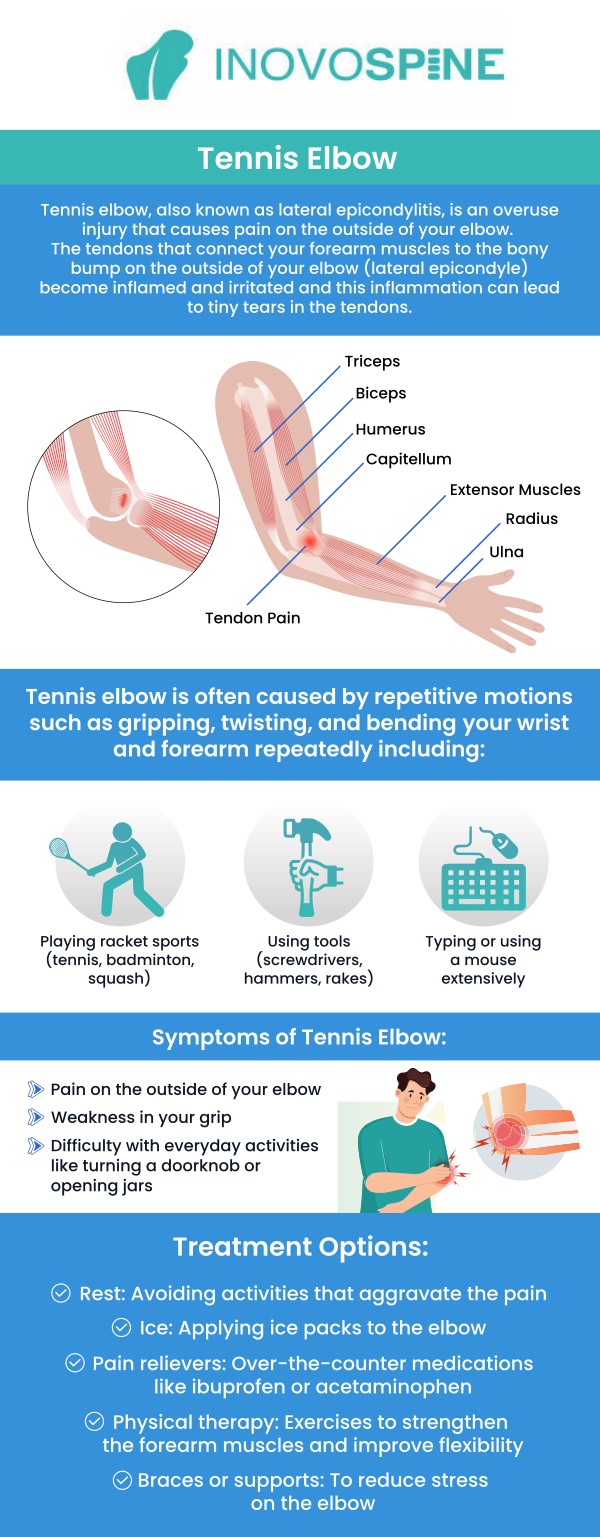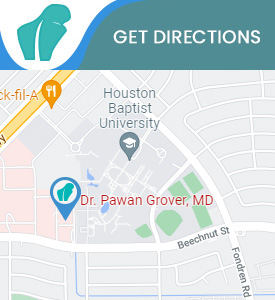Tennis Elbow Treatment Specialist in Houston, TX
At InovoSpine, Dr. Pawan Grover, MDPA, specializes in diagnosing and treating tennis elbow with personalized, non-surgical, and advanced treatment options. Whether through physical therapy, medication, or minimally invasive procedures, we are committed to helping you find relief and regain function. For more information, contact us or book an appointment online. We are conveniently located at 1140 Business Center Dr, Suite 110, Houston, TX 77043.




Table of Contents:
What is tennis elbow and what causes it?
What are the symptoms of tennis elbow?
How is tennis elbow diagnosed?
What are the treatment options for tennis elbow?
Tennis elbow, medically known as lateral epicondylitis, is a condition characterized by pain and inflammation on the outside of the elbow. It occurs when the tendons that attach to the lateral epicondyle (the bony bump on the outside of the elbow) become overloaded or damaged. While commonly associated with tennis players, it can affect anyone who repetitively uses their forearm muscles and tendons, including people who engage in activities like painting, typing, or using tools.
The primary cause of tennis elbow is repetitive motion that strains the muscles and tendons in the forearm, leading to microtears. These tears result in inflammation and pain around the elbow joint. Actions that involve gripping, twisting, or lifting with the wrist, especially when done improperly or excessively, can contribute to the condition. For instance, athletes who play racquet sports or individuals who lift heavy objects regularly are at higher risk.
Although tennis elbow can affect anyone, certain factors increase the likelihood of developing the condition. These include age (most commonly between 30 and 50 years old), repetitive motions in work or sports, and improper techniques when performing certain activities. Individuals with jobs or hobbies that require frequent hand and wrist use, such as carpenters, painters, or gardeners, are more prone to this condition. Strengthening exercises and proper ergonomics can help reduce the risk of developing tennis elbow.
The main symptom of tennis elbow is pain or tenderness on the outer part of the elbow, specifically around the bony bump known as the lateral epicondyle. This pain can radiate down the forearm and may worsen with activities that involve gripping, lifting, or twisting the wrist. In the early stages, the pain might be mild but can become more intense over time, especially after repetitive movements. The discomfort may also persist during rest if the condition is left untreated.
Other symptoms associated with tennis elbow include weakness in the affected arm, which can make it difficult to hold objects, shake hands, or perform certain tasks like turning a doorknob. The pain might intensify when extending the wrist or using the forearm muscles, and in some cases, swelling or inflammation can be present near the elbow joint. These symptoms can limit daily activities and, if left untreated, may lead to long-term discomfort and disability.
Common Symptoms:
• Pain or tenderness on the outside of the elbow
• Weakness in the forearm and wrist
• Pain worsens with gripping, lifting, or twisting motions
• Swelling or inflammation in the elbow region
• Difficulty with tasks requiring a firm grip, like shaking hands or holding objects
Diagnosing tennis elbow typically begins with a comprehensive evaluation, where healthcare professionals review the patient’s medical history and discuss symptoms in detail. Understanding the onset, triggers, and intensity of pain is essential for creating an accurate diagnosis. A physical examination follows, with the physician palpating the outer elbow area to check for pain, swelling, or tenderness around the lateral epicondyle, the bony prominence on the elbow’s outer side.
In addition to a physical exam, specific tests are often performed. These may involve extending the wrist or fingers against resistance to provoke pain, helping pinpoint the affected tendons and muscles. If the diagnosis remains unclear or additional conditions need to be ruled out, advanced imaging tests, such as X-rays or MRIs, are used to evaluate the soft tissues, joints, and bones. These tools help to rule out other issues, like fractures or arthritis, and ensure an accurate diagnosis of tennis elbow.
A thorough and personalized diagnostic process ensures that tennis elbow is identified correctly, guiding the development of an effective treatment plan that addresses both symptoms and underlying causes.
At InovoSpine, we understand the challenges that conditions like tennis elbow can pose to your daily life and overall well-being. Our comprehensive approach to treating lateral epicondylitis is designed to alleviate pain, promote healing, and help you return to your normal activities as quickly and safely as possible.
• Personalized Treatment Plans: Our team of specialists is dedicated to providing individualized care tailored to your specific needs. We begin with a thorough evaluation to understand the extent of your condition and any contributing factors. This allows us to create a customized treatment plan that addresses both symptoms and underlying causes.
• Conservative Management: InovoSpine emphasizes the importance of starting with non-invasive treatments. Our therapists guide you through exercises that strengthen the forearm muscles and enhance flexibility, reducing strain on the elbow. We also offer cutting-edge techniques such as ultrasound therapy and manual therapy to facilitate recovery. For immediate relief, we can advise on the use of ice therapy and over-the-counter pain medications.
• Advanced Interventions: When conservative measures are insufficient, options like corticosteroid or platelet-rich plasma (PRP) injections help to reduce inflammation and promote healing.
• Surgical Expertise: In rare cases where surgery is necessary, both open and minimally invasive arthroscopic procedures remove damaged tissue.
At InovoSpine, your recovery is our priority. We encourage anyone experiencing symptoms of tennis elbow to reach out for a consultation. For more information, contact us or book an appointment online. We are located at 1140 Business Center Dr, Suite 110, Houston TX 77043. We serve patients from Houston TX, Hedwig Village TX, Meadows Place TX, Missouri City TX, Hunters Creek Village TX, Spring Valley Village TX, and surrounding areas.

Additional Service You May Need
- Regenerative Medicine
- Spinal Arthritis
- Diagnostic Mapping
- Interventional Pain
- Minimally Invasive
- Spine Pain
- Radiofrequency Ablation
- Spinal Cord Stimulation
- Physical Rehabilitation
- Facet Joint Pain
- Herniated Discs
- Muscle and Joint Pain
- Post-Laminectomy Pain
- Myofascial Pain
- Peripheral Nerve Pain
- Regional Pain Syndrome









